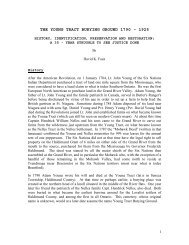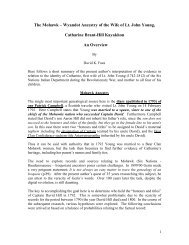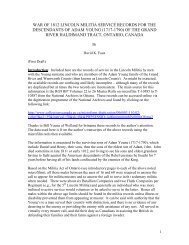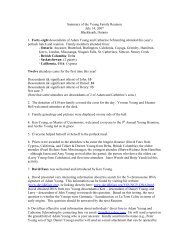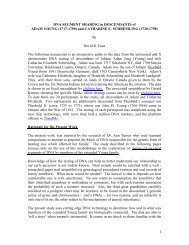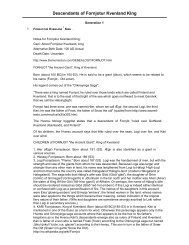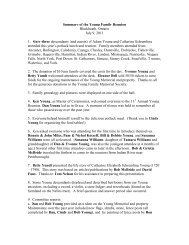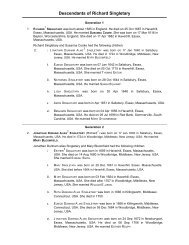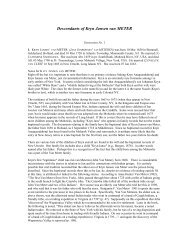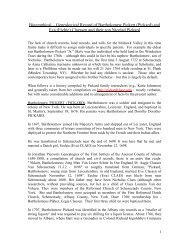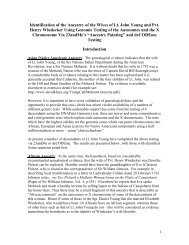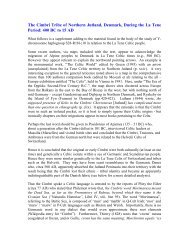R-M269 world into east and west, and all were established to be p49a,f Taq haplotype 35(Eastern), whereas the Western variety is 15 (although no known U106 or U152individuals have been tested for the p49a,f marker). In addition, the majority of samples(Cinnioglu includes haplotypes with10 YSTR markers) have DYS393=12 andDYS461=11, classic indicators of the Eastern variety. An inspection of each haplotypeshows 9 individuals who do have the Western 13/12 motif on the above markers. So 76of the sample of 523 were R-M269, and 2 were R-U106. This leaves, realistically, 7(7%) who may be R-U152. A few individuals who have the 12/11 motif, although fromwestern countries, have tested R-M269*. Perhaps their ancestors were recruited from theBalkan region to serve in the Roman Army, being deployed to locations such as England.R-U152 findings – None tested to date.OTHER: Even in the days of the La Tene peoples (let alone circumstances relating tomodern transportation over the past few hundred years), people travelled more widelythan this study has yet noted. Just as an example, after the sack of Delphi in 279 BC,various nations in the region began to hire the Celts as mercinaries in places as far awayas Syria (where 15% R has been observed in a sample of 20 as reported in Semino et al.,2000). In 217 BC there were 14,000 Celts in the army of pharaoh Ptolemy IV of Egypt(Ellis, 1998). In Hadra, southeast of Alexandria, Egypt funerary stelae naming variousGauls are found in a Celtic cemetery, thus suggesting that some groups in far off landsretained their identities until, in this case, the last century BC (Cunliffe, 1997). Rafferty(2001) notes that Celtic mercinaries were recruited during the 3 rd Century BC insoutheast Europe to serve at Alexandria, Fayum, and Abydos (the latter well up the NileRiver), Egypt. Whether these people buried here left descendants living to this day is anopen question. Dieterien and Lucotte (2005) examined the distribution of p49a,f TaqHaplotype 15 (associated with the “Western” variety of R-M269). The large (n=162)sample from Alexandria, Egypt found 7% Haplotype 15; and 11% of 102 Moroccanswere Haplotype 15 - all potential Celt descendants.It may be important to examine the haplogroups for Ashkenazi and Sephardic Jews.Although an ethnic – religious group, years of isolation mean that there will be somehaplogroups and haplotypes more characteristic of Jews compared to others residing inthe same country (e.g., Hungary). Their migrational history is entirely different from thatof their surrounding neighbors. An inspection of the R Jewish DNA Project illustratesthe diversity within this group, largely with ancestry in Eastern Europe. A largepercentage are clearly of the “Eastern” variety of R-M269 with DYS393=12 andDYS426=11. Others are more typical of the western haplotypes. Behar et al. (2003) onlygenotyped to P*(xR1a) which could include haplogroups Q, R1* and others, but most areprobably R-M269. Percentages varied between Ashkenazi Cohen with 3% to SephrdicIsrealis at 21%. Behar et al. (2004) did a deeper level of genotyping, although only toP25-R1* (the percentage which are R-M269 is likely the majority here), and found 09%of Ashkenazi Jews in this category. Assuming that all were R-M269 (there were perhapssome P25+ who were not M269+, being R1*), then using only the haplotypes that can beclearly classified as “Eastern” (DYS393=12; DYS426=11) or “Western” (DYS393=13;46
DYS426=12), then 22% were in the former category and 78% in the latter. Hence anunknown percentage of Ashkenazi may be R-U152 (or R-U106 as well as R-M269*).The Jewish R DNA Project has an increasing number of members who have tested R-U152. Although the reported ancestral origin of members of this project includecountries from Latvia on the Baltic south to Ukraine in Eastern Europe. It appears likelythat their ancestors migrated from the Upper Rhine area, the first documented reference isto Cologne on the Rhine in 391 AD, and soon after to Worms and Mainz – all in thesouth of Germany. At a later point the Ashkenazi Jews shifted their center of gravity tothe east (as far east as Russia and the Ukraine). Some in that region may be due to localintrogression, but the percentage of R-U152 in Russia for example is likely to be low tonon-existant. There are a few haplotypes, clearly related, but with high diversity, thatsuggest a founder effect where a few R-U152 men may have been the ancestors of a verylarge number of Jewish men living today in Eastern Europe. Most have not been testedfor DYS492, but there is a large diverse group with a rare haplotype (e.g., DYS385a=14)and the DYS492=14 which places them in a clade found most commonly in southernGermans. Other Ashkenazi have the modal value of 12 (or in one case 11), which is stillthe most common motif across the R-U152 world.Commercial Testing Summary of U152-R-U152 by Country and Region:Table 1. Geographical distribution of U152 tested and other R-M269 derivedindividualsOrigin - + Total %England 30 4 34 12Europe 12 7 19 37Ireland 47 0 47 0Scotland 21 1 22 5unknown 52 1 53 2Wales 4 0 4 0Total 166 13 179 7The above table was completed 27 October 2006, based on data then available, by Dr.John McEwen. He indicates that the data points to a number of conclusions. The first is thehigh % of those tested in Europe in haplogroup R (defined as west of the Black Sea) that areU152+ and the second is that the level in England is one third of Europe, and it declines again inScotland and Ireland. These results do have some biases, but they coincide with other evidence.The numbers publicly available strongly support a high prevalence in Europe.See full analysis click here.Other Haplogroups: It is also very likely that the La Tene Celts were composed ofother haplogroups, although perhaps none so plentiful as R-U152. It is likely that eachmoved up the Danube or into the eastern La Tene Celtic territories at varying times.Investigations by Ken Nordtvedt (personal communication, 2007), suggest that these arespecific groupings which tend to cluster in areas where the La Tene Celts were known to47



